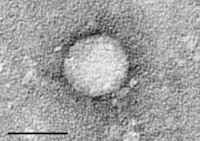
Photo from wikipedia
Background Viral hepatitis is a widespread and serious infectious disease, and most patients with liver cirrhosis and hepatocellular carcinoma are prone to viral infections. T cell immunoglobulin-and mucin-domain-containing molecule-3 (Tim-3)… Click to show full abstract
Background Viral hepatitis is a widespread and serious infectious disease, and most patients with liver cirrhosis and hepatocellular carcinoma are prone to viral infections. T cell immunoglobulin-and mucin-domain-containing molecule-3 (Tim-3) is an immune checkpoint molecule that negatively regulates T cell responses, playing an extremely important role in controlling infectious diseases. However, reports about the role of serum soluble Tim-3 (sTim-3) in hepatitis virus infection are limited. Therefore, this study explored changes in sTim-3 levels in patients infected with hepatitis B virus (HBV), hepatitis C virus (HCV), and hepatitis E virus (HEV). Methods This study applied high-sensitivity time-resolved fluorescence immunoassay for the detection of sTim-3 levels. A total of 205 cases of viral hepatitis infection (68 cases of HBV infection, 60 cases of HCV infection, and 77 cases of HEV virus infection) and 88 healthy controls were quantitatively determined. The changes in serum sTim-3 level and its clinical value in hepatitis virus infection were analyzed. Results Patients with HBV infection (14.00, 10.78–20.45 ng/mL), HCV infection (15.99, 11.83–27.00 ng/mL), or HEV infection (19.09, 10.85–33.93 ng/mL) had significantly higher sTim-3 levels than that in the healthy control group (7.69, 6.14–10.22 ng/mL, P < 0.0001). Patients with hepatitis and fibrosis infected with HBV (22.76, 12.82–37.53 ng/mL), HCV (33.06, 16.36–39.30 ng/mL), and HEV (28.90, 17.95–35.94 ng/mL) had significantly higher sTim-3 levels than patients with hepatitis without fibrosis (13.29, 7.75–17.28; 13.86, 11.48–18.64; 14.77, 9.79–29.79 ng/mL; P < 0.05). Conclusion sTim-3 level was elevated in patients infected with HBV, HCV, or HEV and gradually increased in patients with either hepatitis or hepatitis with hepatic fibrosis. It has a certain role in the evaluation of the course of a disease after hepatitis virus infection.
Journal Title: Frontiers in Medicine
Year Published: 2022
Link to full text (if available)
Share on Social Media: Sign Up to like & get
recommendations!